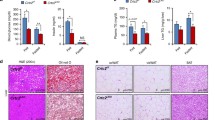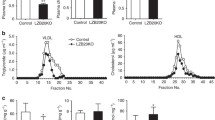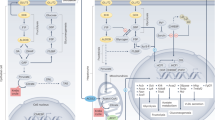Abstract
Carbohydrate response element binding protein (ChREBP) regulates insulin-independent de novo lipogenesis. Recently, a novel ChREBPβ isoform was identified. The purpose of the current study was to define the effect of dietary carbohydrates (CHO) and obesity on the transcriptional activity of ChREBP isoforms and their respective target genes. Mice were subjected to fasting-refeeding of high-CHO diets. In all three CHO-refeeding groups, mice failed to induce ChREBPα, yet ChREBPβ increased 10- to 20-fold. High-fat fed mice increased hepatic ChREBPβ mRNA expression compared to chow-fed along with increased protein expression. To better assess the independent effect of fructose on ChREBPα/β activity, HepG2 cells were treated with fructose ± a fructose-1,6-bisphosphatase inhibitor to suppress gluconeogenesis. Fructose treatment in the absence of gluconeogenesis resulted in increased ChREBP activity. To confirm the existence of ChREBPβ in human tissue, primary hepatocytes were incubated with high-glucose and the expression of ChREBPα and -β was determined. As with the animal models, glucose induced ChREBPβ expression while ChREBPα was decreased. Taken together, ChREBPβ is more responsive to changes in dietary CHO availability than the -α isoform. Diet-induced obesity increases basal expression of ChREBPβ, which may increase the risk of developing hepatic steatosis, and fructose-induced activation is independent of gluconeogenesis.







Similar content being viewed by others
Abbreviations
- ChREBP:
-
Carbohydrate response element binding protein
- CHO:
-
Carbohydrates
- DNL:
-
De novo lipogenesis
- TG:
-
Triglycerides
- NAFLD:
-
Non-alcoholic fatty liver disease
- LID:
-
Low-glucose inhibitory domain
- GNG:
-
Gluconeogenesis
- IPGTT:
-
Intraperitoneal glucose tolerance tests
- RNAP2:
-
RNA polymerase II
- PCR:
-
Polymerase chain reaction
- FBPase-1:
-
Fructose-1,6-bisphosphatase
- DMEM:
-
Dulbecco’s modified Eagle’s medium
- RPMI:
-
Roswell Park Memorial Institute medium
- cDNA:
-
Complementary DNA
- SEM:
-
Standard error of the mean
- L-PK:
-
Liver pyruvate kinase
- SCD-1:
-
Stearoyl-CoA desaturase-1
- FOXO1:
-
Forkhead box protein O1
- PGC-1α:
-
Peroxisome proliferator-activated receptor gamma coactivator-1α
- PEPCK:
-
Phosphoenolpyruvate carboxykinase
- G6Pase:
-
Glucose-6-phosphatase
- mRNA:
-
Messenger RNA
- LG:
-
Low glucose
- HG:
-
High glucose
- LF:
-
Low fructose
- HF:
-
High fructose
- ACCα:
-
Acetyl-CoA carboxylase-α
- FASN:
-
Fatty acid synthase
- TXNIP:
-
Thioredoxin-interacting protein
- KHK:
-
Ketohexokinase
- HFD:
-
High-fat diet
- UnT:
-
Untreated
- X5P:
-
Xylulose-5-phosphate
References
Davies MN, O’Callaghan BL, Towle HC (2008) Glucose activates ChREBP by increasing its rate of nuclear entry and relieving repression of its transcriptional activity. J Biol Chem 283:24029–24038
Yamashita H, Takenoshita M, Sakurai M, Bruick RK, Henzel WJ, Shillinglaw W, Arnot D, Uyeda K (2001) A glucose-responsive transcription factor that regulates carbohydrate metabolism in the liver. Proc Natl Acad Sci USA 98:9116–9121
Ishii S, Iizuka K, Miller BC, Uyeda K (2004) Carbohydrate response element binding protein directly promotes lipogenic enzyme gene transcription. Proc Natl Acad Sci USA 101:15597–15602
Janevski M, Ratnayake S, Siljanovski S, McGlynn MA, Cameron-Smith D, Lewandowski P (2012) Fructose containing sugars modulate mRNA of lipogenic genes ACC and FAS and protein levels of transcription factors ChREBP and SREBP1c with no effect on body weight or liver fat. Food Funct 3:141–149
del Hurtado PC, Vesperinas-Garcia G, Rubio MA, Corripio-Sanchez R, Torres-Garcia AJ, Obregon MJ, Calvo RM (2011) ChREBP expression in the liver, adipose tissue and differentiated preadipocytes in human obesity. Biochim Biophys Acta 1811:1194–1200
Denechaud PD, Dentin R, Girard J, Postic C (2008) Role of ChREBP in hepatic steatosis and insulin resistance. FEBS Lett 582:68–73
Herman MA, Peroni OD, Villoria J, Schon MR, Abumrad NA, Bluher M, Klein S, Kahn BB (2012) A novel ChREBP isoform in adipose tissue regulates systemic glucose metabolism. Nature 484:333–338
Strable MS, Ntambi JM (2010) Genetic control of de novo lipogenesis: role in diet-induced obesity, Crit Rev. Biochem Mol Biol 45:199–214
Sampath H, Miyazaki M, Dobrzyn A, Ntambi JM (2007) Stearoyl-CoA desaturase-1 mediates the pro-lipogenic effects of dietary saturated fat. J Biol Chem 282:2483–2493
Shimomura I, Matsuda M, Hammer RE, Bashmakov Y, Brown MS, Goldstein JL (2000) Decreased IRS-2 and increased SREBP-1c lead to mixed insulin resistance and sensitivity in livers of lipodystrophic and ob/ob mice. Mol Cell 6:77–86
Horton JD, Bashmakov Y, Shimomura I, Shimano H (1998) Regulation of sterol regulatory element binding proteins in livers of fasted and refed mice. Proc Natl Acad Sci USA 95:5987–5992
Rogowski MP, Flowers MT, Stamatikos AD, Ntambi JM, Paton CM (2013) SCD1 activity in muscle increases triglyceride PUFA content, exercise capacity, and PPARδ expression in mice. J Lipid Res 54:2636–2646
Mercer DF, Schiller DE, Elliott JF, Douglas DN, Hao C, Rinfret A, Addison WR, Fischer KP, Churchill TA, Lakey JR, Tyrrell DL, Kneteman NM (2001) Hepatitis C virus replication in mice with chimeric human livers. Nat Med 7:927–933
Eissing L, Scherer T, Todter K, Knippschild U, Greve JW, Buurman WA, Pinnschmidt HO, Rensen SS, Wolf AM, Bartelt A, Heeren J, Buettner C, Scheja L (2013) De novo lipogenesis in human fat and liver is linked to ChREBP-beta and metabolic health. Nat Commun 4:1528
Kursawe R, Caprio S, Giannini C, Narayan D, Lin A, D’Adamo E, Shaw M, Pierpont B, Cushman SW, Shulman GI (2013) Decreased transcription of ChREBP-α/β isoforms in abdominal subcutaneous adipose tissue of obese adolescents with prediabetes or early type 2 diabetes: associations with insulin resistance and hyperglycemia. Diabetes 62:837–844
Benhamed F, Denechaud PD, Lemoine M, Robichon C, Moldes M, Bertrand-Michel J, Ratziu V, Serfaty L, Housset C, Capeau J, Girard J, Guillou H, Postic C (2012) The lipogenic transcription factor ChREBP dissociates hepatic steatosis from insulin resistance in mice and humans. J Clin Invest 122:2176–2194
Jeong YS, Kim D, Lee YS, Kim HJ, Han JY, Im SS, Chong HK, Kwon JK, Cho YH, Kim WK, Osborne TF, Horton JD, Jun HS, Ahn YH, Ahn SM, Cha JY (2011) Integrated expression profiling and genome-wide analysis of ChREBP targets reveals the dual role for ChREBP in glucose-regulated gene expression. PLoS One 6:e22544
Pender C, Trentadue AR, Pories WJ, Dohm GL, Houmard JA, Youngren JF (2006) Expression of genes regulating malonyl-CoA in human skeletal muscle. J Cell Biochem 99:860–867
Billin AN, Eilers AL, Coulter KL, Logan JS, Ayer DE (2000) MondoA, a novel basic helix-loop-helix-leucine zipper transcriptional activator that constitutes a positive branch of a max-like network. Mol Cell Biol 20:8845–8854
Sloan EJ, Ayer DE (2010) Myc, mondo, and metabolism. Genes Cancer 1:587–596
Kabashima T, Kawaguchi T, Wadzinski BE, Uyeda K (2003) Xylulose 5-phosphate mediates glucose-induced lipogenesis by xylulose 5-phosphate-activated protein phosphatase in rat liver. Proc Natl Acad Sci USA 100:5107–5112
Acknowledgments
A.D.S. prepared the manuscript and conducted mouse and cell experiments; R.P.S., N.M.K., J.T.L., D.N.D., and R.L.J. assisted in manuscript preparation and conducted primary hepatocyte studies; C.M.P. prepared the manuscript, conducted, and directed studies. This research was supported by Grant (133505) from the Canadian Institutes of Health Research (CIHR). R.L.J. is a CIHR New Investigator.
Author information
Authors and Affiliations
Corresponding author
Ethics declarations
Conflict of interest
The authors have no conflicts of interest.
Electronic supplementary material
Below is the link to the electronic supplementary material.
About this article
Cite this article
Stamatikos, A.D., da Silva, R.P., Lewis, J.T. et al. Tissue Specific Effects of Dietary Carbohydrates and Obesity on ChREBPα and ChREBPβ Expression. Lipids 51, 95–104 (2016). https://doi.org/10.1007/s11745-015-4090-0
Received:
Accepted:
Published:
Issue Date:
DOI: https://doi.org/10.1007/s11745-015-4090-0




